The Properties of Microwave-Assisted Synthesis of Metal–Organic Frameworks and Their Applications
Abstract
1. Introduction
- The initial method was carried out mainly through diffusion or slow evaporation for a long duration (days to months) to produce large single crystals.
- This was followed by the application of a solvothermal process, which is a conventional method for the synthesis of zeolites. Although the solvothermal process decreased the synthesis time from months to some days, the formation of microcrystalline powders became more prominent. Viscous gels or amorphous solids are generally obtained through solvothermal synthesis, particularly for Hf-MOFs. Hence, the method required huge manipulations for the formation of a single crystal.
- Another commonly used technique for the preparation of MOFs is a hydrothermal synthesis, which also requires a long duration for the reaction to complete, extending from multiple hours to days. Thus, the crystal engineers had to find an efficient method for decreasing the synthesis time of MOFs along with the formation of structured crystals.
2. Properties of MOFs
2.1. MOF Stability
2.2. Porosity
2.3. Crystallinity
2.4. Photoluminescence
3. The Analysis of the Efficiency of the Process
3.1. Reaction Mass Efficiency (RME)
3.2. Energy Supplied (μ)
3.3. The Space–Time Yield
3.4. Modulators
3.5. Kinetic Studies
3.6. Activation of MOFs by MW
- a.
- The value of more than 0.5 indicates high MW-absorbing solvents (EtOH, DMSO, and ethylene glycol)
- b.
- The value of within 0.1–0.5 indicates medium MW-absorbing solvents (water and CH3CN)
- c.
- The value of less than 0.1 indicates low MW-absorbing solvents.
3.7. The Absorption of MW
4. The MW-Assisted Synthesis of MOFs
4.1. The Solvent-Free Condition
4.2. Continuous-Flow MW-Assisted Reactors (CFMR)
4.3. MW-Assisted Dry-Gel Conversion (MW–DGC)
4.4. The MW-Assisted Ball-Mill Process
5. Advantages of MW-Synthesised MOFs According to Their Geometry and Applications
5.1. Catalysts
5.2. Adsorption: Gases and Organic Compounds
5.3. Drug Loading
5.4. The Separation of Anthraquinones
5.5. The Preparation of Thin Films
5.6. Supercapacitor Materials
5.7. Materials for Lithium–Sulphur Batteries (LIBs)
6. Future Perspectives and Conclusions
7. Conclusions
Author Contributions
Funding
Institutional Review Board Statement
Informed Consent Statement
Data Availability Statement
Conflicts of Interest
References
- Zhang, Z.; Huo, G.; Si, F.; Fu, X.Z.; Liu, S.Q.; Luo, J.L. MOF Derived Manganese Oxides Nanospheres Embedded in N-Doped Carbon for Oxygen Reduction Reaction. Inorganics 2022, 10, 126. [Google Scholar] [CrossRef]
- Liu, S.; Qiu, Y.; Liu, Y.; Zhang, W.; Dai, Z.; Srivastava, D.; Kumar, A.; Pan, Y.; Liu, J. Recent advances in bimetallic metal-organic frameworks (BMOFs): Synthesis, applications and challenges. N. J. Chem. 2022, 46, 13818–13837. [Google Scholar] [CrossRef]
- Lazarou, S.; Antonoglou, O.; Mourdikoudis, S.; Serra, M.; Sofer, Z.; Dendrinou-Samara, C. Magnetic Nanocomposites of Coated Ferrites/MOF as Pesticide Adsorbents. Molecules 2023, 28, 39. [Google Scholar] [CrossRef] [PubMed]
- Ta, Q.T.H.; Cho, E.; Sreedhar, A.; Noh, J.-S. Mixed-Dimensional, Three-Level Hierarchical Nanostructures of Silver and Zinc Oxide for Fast Photocatalytic Degradation of Multiple Dyes. J. Catal. 2019, 371, 1–9. [Google Scholar] [CrossRef]
- Qin, L.; Li, Y.; Liang, F.; Li, L.; Lan, Y.; Li, Z.; Lu, X.; Yang, M.; Ma, D. A microporous 2D cobalt-based MOF with pyridyl sites and open metal sites for selective adsorption of CO2. Microporous Mesoporous Mater. 2022, 341, 112098. [Google Scholar] [CrossRef]
- Li, M.; Yin, S.; Lin, M.; Chen, X.; Pan, Y.; Peng, Y.; Sun, J.; Kumar, A.; Liu, J. Current status and prospects of metal-organic frameworks for bone therapy and bone repair. J. Mater. Chem. B 2022, 10, 5105–5128. [Google Scholar] [CrossRef]
- Wu, H.B.; Lou, X.W. Metal-organic frameworks and their derived materials for electrochemical energy storage and conversion: Promises and challenges. Sci. Adv. 2017, 3, 1–17. [Google Scholar] [CrossRef]
- Thanh, Q.; Ta, H.; Tran, N.M.; Noh, J. Rice Crust-Like ZnO /Ti3C2Tx MXene Hybrid Structures for Improved Photocatalytic Activity. Catalysts 2020, 10, 1140. [Google Scholar]
- Cao, X.; Tan, C.; Sindoro, M.; Zhang, H. Hybrid micro-/nano-structures derived from metal-organic frameworks: Preparation and applications in energy storage and conversion. Chem. Soc. Rev. 2017, 46, 2660–2677. [Google Scholar] [CrossRef]
- Zheng, M.; Chen, J.; Zhang, L.; Cheng, Y.; Lu, C.; Liu, Y.; Singh, A.; Trivedi, M.; Kumar, A.; Liu, J. Metal organic frameworks as efficient adsorbents for drugs from wastewater. Mater. Today Commun. 2022, 31, 103514. [Google Scholar] [CrossRef]
- Hoskins, B.F.; Robson, R. Design and Construction of a New Class of Scaffolding-like Materials Comprising Infinite Polymeric Frameworks of 3D-Linked Molecular Rods. A Reappraisal of the Zn(CN)2 and Cd(CN)2 Structures and the Synthesis and Structure of the Diamond-Related Framework. J. Am. Chem. Soc. 1990, 112, 1546–1554. [Google Scholar] [CrossRef]
- Cheetham, A.K.; Fe, Â.; Loiseau, T. New materials try to emulate nature s open frameworks. Angew. Chem. Int. Ed. 1999, 38, 3269. [Google Scholar]
- Cundy, C.S.; Cox, P.A. The hydrothermal synthesis of zeolites: History and development from the earliest days to the present time. Chem. Rev. 2003, 103, 663–701. [Google Scholar] [CrossRef] [PubMed]
- Janiak, C. Engineering coordination polymers towards applications. J. Chem. Soc. Dalt. Trans. 2003, 3, 2781–2804. [Google Scholar] [CrossRef]
- Kitchen, H.J.; Vallance, S.R.; Kennedy, J.L.; Tapia-Ruiz, N.; Carassiti, L.; Harrison, A.; Whittaker, A.G.; Drysdale, T.D.; Kingman, S.W.; Gregory, D.H. Modern microwave methods in solid-state inorganic materials chemistry: From fundamentals to manufacturing. Chem. Rev. 2014, 114, 1170–1206. [Google Scholar] [CrossRef]
- Reeja-Jayan, B.; Harrison, K.L.; Yang, K.; Wang, C.L.; Yilmaz, A.E.; Manthiram, A. Microwave-assisted low-temperature growth of thin films in solution. Sci. Rep. 2012, 2, 1003. [Google Scholar] [CrossRef]
- Baumann, A.E.; Burns, D.A.; Liu, B.; Thoi, V.S. Metal-organic framework functionalization and design strategies for advanced electrochemical energy storage devices. Commun. Chem. 2019, 2, 86. [Google Scholar] [CrossRef]
- Yuan, S.; Feng, L.; Wang, K.; Pang, J.; Bosch, M.; Lollar, C.; Sun, Y.; Qin, J.; Yang, X.; Zhang, P.; et al. Stable Metal–Organic Frameworks: Design, Synthesis, and Applications. Adv. Mater. 2018, 30, 1704303. [Google Scholar] [CrossRef]
- Ta, Q.T.H.; Tran, N.M.; Tri, N.N.; Sreedhar, A.; Noh, J.-S. Highly Surface-Active Si-Doped TiO2/Ti3C2Tx Heterostructure for Gas Sensing and Photodegradation of Toxic Matters. Chem. Eng. J. 2021, 425, 131437. [Google Scholar] [CrossRef]
- Klinowski, J.; Almeida Paz, F.A.; Silva, P.; Rocha, J. Microwave-assisted synthesis of metal-organic frameworks. Dalt. Trans. 2011, 40, 321–330. [Google Scholar] [CrossRef]
- Khan, N.A.; Jhung, S.H. Synthesis of metal-organic frameworks (MOFs) with microwave or ultrasound: Rapid reaction, phase-selectivity, and size reduction. Coord. Chem. Rev. 2015, 285, 11–23. [Google Scholar] [CrossRef]
- Thomas-Hillman, I.; Laybourn, A.; Dodds, C.; Kingman, S.W. Realising the environmental benefits of metal-organic frameworks: Recent advances in microwave synthesis. J. Mater. Chem. A 2018, 6, 11564–11581. [Google Scholar] [CrossRef]
- Gulcay, E.; Erucar, I. Metal-organic frameworks for biomedical applications. In Two-Dimensional Nanostructures for Biomedical Technology: A Bridge between Material Science and Bioengineering; Elsevier: Amsterdam, The Netherlands, 2019; pp. 173–210. [Google Scholar] [CrossRef]
- Wang, C.; Liu, X.; Keser Demir, N.; Chen, J.P.; Li, K. Applications of water stable metal-organic frameworks. Chem. Soc. Rev. 2016, 45, 5107–5134. [Google Scholar] [CrossRef]
- Burtch, N.C.; Jasuja, H.; Walton, K.S. Water stability and adsorption in metal-organic frameworks. Chem. Rev. 2014, 114, 10575–10612. [Google Scholar] [CrossRef] [PubMed]
- Howarth, A.J.; Liu, Y.; Li, P.; Li, Z.; Wang, T.C.; Hupp, J.T.; Farha, O.K. Chemical, thermal and mechanical stabilities of metal-organic frameworks. Nat. Rev. Mater. 2016, 1, 15018. [Google Scholar] [CrossRef]
- Yeh, C.T.; Lin, W.C.; Lo, S.H.; Kao, C.C.; Lin, C.H.; Yang, C.C. Microwave synthesis and gas sorption of calcium and strontium metal-organic frameworks with high thermal stability. CrystEngComm 2012, 14, 1219–1222. [Google Scholar] [CrossRef]
- Sun, L.; Yin, M.; Li, Z.; Tang, S. Facile microwave-assisted solvothermal synthesis of rod-like aluminum terephthalate [MIL-53(Al)] for CO2 adsorption. J. Ind. Eng. Chem. 2022, 112, 279–286. [Google Scholar] [CrossRef]
- Devic, T.; Serre, C. High valence 3p and transition metal based MOFs. Chem. Soc. Rev. 2014, 43, 6097–6115. [Google Scholar] [CrossRef]
- Férey, C.; Mellot-Draznieks, C.; Serre, C.; Millange, F.; Dutour, J.; Surblé, S.; Margiolaki, I. Chemistry: A chromium terephthalate-based solid with unusually large pore volumes and surface area. Science 2005, 309, 2040–2042. [Google Scholar] [CrossRef]
- Serre, C.; Millange, F.; Thouvenot, C.; Noguès, M.; Marsolier, G.; Louër, D.; Férey, G. Very large breathing effect in the first nanoporous chromium(III)-based solids: MIL-53 or CrIII(OH)·{O2C−C6H4−CO2}·{HO2C−C6H4−CO2H}x·H2Oy. J. Am. Chem. Soc. 2002, 124, 13519–13526. [Google Scholar] [CrossRef]
- Cavka, J.H.; Jakobsen, S.; Olsbye, U.; Guillou, N.; Lamberti, C.; Bordiga, S.; Lillerud, K.P. A new zirconium inorganic building brick forming metal organic frameworks with exceptional stability. J. Am. Chem. Soc. 2008, 130, 13850–13851. [Google Scholar] [CrossRef]
- Park, K.S.; Ni, Z.; Côté, A.P.; Choi, J.Y.; Huang, R.; Uribe-Romo, F.J.; Chae, H.K.; O’Keeffe, M.; Yaghi, O.M. Exceptional chemical and thermal stability of zeolitic imidazolate frameworks. Proc. Natl. Acad. Sci. USA 2006, 103, 10186–10191. [Google Scholar] [CrossRef] [PubMed]
- Wei, Z.; Gu, Z.Y.; Arvapally, R.K.; Chen, Y.P.; McDougald, R.N.; Ivy, J.F.; Yakovenko, A.A.; Feng, D.; Omary, M.A.; Zhou, H.C. Rigidifying fluorescent linkers by metal-organic framework formation for fluorescence blue shift and quantum yield enhancement. J. Am. Chem. Soc. 2014, 136, 8269–8276. [Google Scholar] [CrossRef]
- Martin, A.D.; Easun, T.L.; Argent, S.P.; Lewis, W.; Blake, A.J.; Schröder, M. The effect of carboxylate position on the structure of a metal organic framework derived from cyclotriveratrylene. CrystEngComm 2017, 19, 603–607. [Google Scholar] [CrossRef]
- Martins, L.; Nasani, R.; Saha, M.; Mobin, S.; Mukhopadhyay, S.; Pombeiro, A. Greener selective cycloalkane oxidations with hydrogen peroxide catalyzed by copper-5-(4-pyridyl)tetrazolate metal-organic frameworks. Molecules 2015, 20, 19203–19220. [Google Scholar] [CrossRef] [PubMed]
- Yang, C.; Kaipa, U.; Mather, Q.Z.; Wang, X.; Nesterov, V.; Venero, A.F.; Omary, M.A. Fluorous metal-organic frameworks with superior adsorption and hydrophobic properties toward oil spill cleanup and hydrocarbon storage. J. Am. Chem. Soc. 2011, 133, 18094–18097. [Google Scholar] [CrossRef]
- Kitao, T.; Zhang, Y.; Kitagawa, S.; Wang, B.; Uemura, T. Hybridization of MOFs and polymers. Chem. Soc. Rev. 2017, 46, 3108–3133. [Google Scholar] [CrossRef]
- Sabouni, R.; Kazemian, H.; Rohani, S. Carbon dioxide adsorption in microwave-synthesized metal organic framework CPM-5: Equilibrium and kinetics study. Microporous Mesoporous Mater. 2013, 175, 85–91. [Google Scholar] [CrossRef]
- Palomino Cabello, C.; Arean, C.O.; Parra, J.B.; Ania, C.O.; Rumori, P.; Turnes Palomino, G. A rapid microwave-assisted synthesis of a sodium-cadmium metal-organic framework having improved performance as a CO2 adsorbent for CCS. Dalt. Trans. 2015, 44, 9955–9963. [Google Scholar] [CrossRef] [PubMed]
- Hong, D.Y.; Hwang, Y.K.; Serre, C.; Férey, G.; Chang, J.S. Porous chromium terephthalate MIL-101 with coordinatively unsaturated sites: Surface functionalization, encapsulation, sorption and catalysis. Adv. Funct. Mater. 2009, 19, 1537–1552. [Google Scholar] [CrossRef]
- Chen, Z.; Hanna, S.L.; Redfern, L.R.; Alezi, D.; Islamoglu, T.; Farha, O.K. Reticular chemistry in the rational synthesis of functional zirconium cluster-based MOFs. Coord. Chem. Rev. 2019, 386, 32–49. [Google Scholar] [CrossRef]
- Chen, C.; Feng, X.; Zhu, Q.; Dong, R.; Yang, R.; Cheng, Y.; He, C. Microwave-Assisted Rapid Synthesis of Well-Shaped MOF-74 (Ni) for CO2 Efficient Capture. Inorg. Chem. 2019, 58, 2717–2728. [Google Scholar] [CrossRef] [PubMed]
- Laybourn, A.; Katrib, J.; Ferrari-John, R.S.; Morris, C.G.; Yang, S.; Udoudo, O.; Easun, T.L.; Dodds, C.; Champness, N.R.; Kingman, S.W.; et al. Metal-organic frameworks in seconds via selective microwave heating. J. Mater. Chem. A 2017, 5, 7333–7338. [Google Scholar] [CrossRef]
- Carlucci, C.; Xu, H.; Scremin, B.F.; Giannini, C.; Altamura, D.; Carlino, E.; Videtta, V.; Conciauro, F.; Gigli, G.; Ciccarella, G. Selective synthesis of TiO2 nanocrystals with morphology control with the microwave-solvothermal method. CrystEngComm 2014, 16, 1817–1824. [Google Scholar] [CrossRef]
- Firmino, A.D.G.; Mendes, R.F.; Ananias, D.; Vilela, S.M.F.; Carlos, L.D.; Tomé, J.P.C.; Rocha, J.; Almeida, F.A. Microwave Synthesis of a photoluminescent Metal-Organic Framework based on a rigid tetraphosphonate linker. Inorg. Chim. Acta 2017, 455, 584–594. [Google Scholar] [CrossRef]
- Zhang, J.; Zheng, B.; Zhao, T.; Li, G.; Huo, Q.; Liu, Y. Topological diversities and luminescent properties of lanthanide metal-organic frameworks based on a tetracarboxylate ligand. Cryst. Growth Des. 2014, 14, 2394–2400. [Google Scholar] [CrossRef]
- Kesuma, R.F.; Patah, A.; Permana, Y. Microwave-assisted synthesis of DUT-52 and investigation of its photoluminescent properties. Bull. Chem. React. Eng. Catal. 2019, 14, 124–129. [Google Scholar] [CrossRef]
- Zhu, G.; Li, X.; Wang, H.; Zhang, L. Microwave assisted synthesis of reduced graphene oxide incorporated MOF-derived ZnO composites for photocatalytic application. Catal. Commun. 2017, 88, 5–8. [Google Scholar] [CrossRef]
- Yang, N.; Zhai, J.; Wang, D.; Chen, Y.; Jiang, L. Two-dimensional graphene bridges enhanced photoinduced charge transport in dye-sensitized solar cells. ACS Nano 2010, 4, 887–894. [Google Scholar] [CrossRef] [PubMed]
- Song, X.; Yan, S. A Sensitivity-Enhanced Sensor Based on Zeroth-Order Resonance for Liquid Characterization. IEEE J. Electromagn. RF Microw. Med. Biol. 2022, 6, 391–398. [Google Scholar] [CrossRef]
- Vallance, S.R.; Kingman, S.; Gregory, D.H. Ultrarapid materials processing: Synthesis of tungsten carbide on subminute timescales. Adv. Mater. 2007, 19, 138–142. [Google Scholar] [CrossRef]
- Tsuruoka, T.; Furukawa, S.; Takashima, Y.; Yoshida, K.; Isoda, S.; Kitagawa, S. Nanoporous nanorods fabricated by coordination modulation and oriented attachment growth. Angew. Chem. Int. Ed. 2009, 48, 4739–4743. [Google Scholar] [CrossRef] [PubMed]
- Sindoro, M.; Yanai, N.; Jee, A.Y.; Granick, S. Colloidal-sized metal-organic frameworks: Synthesis and applications. Acc. Chem. Res. 2014, 47, 459–469. [Google Scholar] [CrossRef]
- Marshall, R.J.; Hobday, C.L.; Murphie, C.F.; Griffin, S.L.; Morrison, C.A.; Moggach, S.A.; Forgan, R.S. Amino acids as highly efficient modulators for single crystals of zirconium and hafnium metal-organic frameworks. J. Mater. Chem. A 2016, 4, 6955–6963. [Google Scholar] [CrossRef]
- Umemura, A.; Diring, S.; Furukawa, S.; Uehara, H.; Tsuruoka, T.; Kitagawa, S. Morphology design of porous coordination polymer crystals by coordination modulation. J. Am. Chem. Soc. 2011, 133, 15506–15513. [Google Scholar] [CrossRef] [PubMed]
- Feng, X.; Wang, Y.; Muhammad, F.; Sun, F.; Tian, Y.; Zhu, G. Size, Shape, and Porosity Control of Medi-MOF-1 via Growth Modulation under Microwave Heating. Cryst. Growth Des. 2019, 19, 889–895. [Google Scholar] [CrossRef]
- Allendorf, M.D.; Schwartzberg, A.; Stavila, V.; Talin, A.A. A roadmap to implementing metal-organic frameworks in electronic devices: Challenges and critical directions. Chem. A Eur. J. 2011, 17, 11372–11388. [Google Scholar] [CrossRef] [PubMed]
- Haque, E.; Khan, N.A.; Park, H.J.; Jhung, S.H. Synthesis of a metal-organic framework material, iron terephthalate, by ultrasound, microwave, and conventional electric heating: A kinetic study. Chem. A Eur. J. 2010, 16, 1046–1052. [Google Scholar] [CrossRef]
- Conner, W.C.; Tompsett, G.; Lee, K.H.; Yngvesson, K.S. Microwave synthesis of zeolites: 1. Reactor engineering. J. Phys. Chem. B 2004, 108, 13913–13920. [Google Scholar] [CrossRef]
- Haque, E.; Jhung, S.H. Synthesis of isostructural metal-organic frameworks, CPO-27s, with ultrasound, microwave, and conventional heating: Effect of synthesis methods and metal ions. Chem. Eng. J. 2011, 173, 866–872. [Google Scholar] [CrossRef]
- Cravotto, G.; Cintas, P. The Combined Use of Microwaves and Ultrasound: Methods and Practice. In Microwaves in Organic Synthesis, 3rd ed.; Wiley: Hoboken, NJ, USA, 2013; Volume 1, pp. 541–562. [Google Scholar] [CrossRef]
- Jhung, S.H.; Jin, T.; Hwang, Y.K.; Chang, J.S. Microwave effect in the fast synthesis of microporous materials: Which stage between nucleation and crystal growth is accelerated by microwave irradiation? Chem. A Eur. J. 2007, 13, 4410–4417. [Google Scholar] [CrossRef] [PubMed]
- Drews, T.O.; Tsapatsis, M. Progress in manipulating zeolite morphology and related applications. Curr. Opin. Colloid Interface Sci. 2005, 10, 233–238. [Google Scholar] [CrossRef]
- Kulkarni, S.A.; Kadam, S.S.; Meekes, H.; Stankiewicz, A.I.; Ter Horst, J.H. Crystal nucleation kinetics from induction times and metastable zone widths. Cryst. Growth Des. 2013, 13, 2435–2440. [Google Scholar] [CrossRef]
- Embrechts, H.; Kriesten, M.; Hoffmann, K.; Peukert, W.; Hartmann, M.; Distaso, M. Elucidation of the Formation Mechanism of Metal-Organic Frameworks via in-Situ Raman and FTIR Spectroscopy under Solvothermal Conditions. J. Phys. Chem. C 2018, 122, 12267–12278. [Google Scholar] [CrossRef]
- Griffin, S.L.; Briuglia, M.L.; ter Horst, J.H.; Forgan, R.S. Assessing Crystallisation Kinetics of Zr Metal–Organic Frameworks through Turbidity Measurements to Inform Rapid Microwave-Assisted Synthesis. Chem. A Eur. J. 2020, 26, 6910–6918. [Google Scholar] [CrossRef]
- Heravi, M.M.; Ghavidel, M.; Mohammadkhani, L. Beyond a solvent: Triple roles of dimethylformamide in organic chemistry. RSC Adv. 2018, 8, 27832–27862. [Google Scholar] [CrossRef]
- Butova, V.V.; Budnyk, A.P.; Charykov, K.M.; Vetlitsyna-Novikova, K.S.; Lamberti, C.; Soldatov, A.V. Water as a structure-driving agent between the UiO-66 and MIL-140A metal-organic frameworks. Chem. Commun. 2019, 55, 901–904. [Google Scholar] [CrossRef] [PubMed]
- Guillerm, V.; Ragon, F.; Dan-Hardi, M.; Devic, T.; Vishnuvarthan, M.; Campo, B.; Vimont, A.; Clet, G.; Yang, Q.; Maurin, G.; et al. A series of isoreticular, highly stable, porous zirconium oxide based metal-organic frameworks. Angew. Chem. Int. Ed. 2012, 51, 9267–9271. [Google Scholar] [CrossRef]
- Sun, H.; Cong, S.; Zheng, Z.; Wang, Z.; Chen, Z.; Zhao, Z. Metal-Organic Frameworks as Surface Enhanced Raman Scattering Substrates with High Tailorability. J. Am. Chem. Soc. 2019, 141, 870–878. [Google Scholar] [CrossRef] [PubMed]
- Cao, C.C.; Chen, C.X.; Wei, Z.W.; Qiu, Q.F.; Zhu, N.X.; Xiong, Y.Y.; Jiang, J.J.; Wang, D.; Su, C.Y. Catalysis through Dynamic Spacer Installation of Multivariate Functionalities in Metal-Organic Frameworks. J. Am. Chem. Soc. 2019, 141, 2589–2593. [Google Scholar] [CrossRef]
- Roth Stefaniak, K.; Epley, C.C.; Novak, J.J.; McAndrew, M.L.; Cornell, H.D.; Zhu, J.; McDaniel, D.K.; Davis, J.L.; Allen, I.C.; Morris, A.J.; et al. Photo-triggered release of 5-fluorouracil from a MOF drug delivery vehicle. Chem. Commun. 2018, 54, 7617–7620. [Google Scholar] [CrossRef] [PubMed]
- Mondloch, J.E.; Karagiaridi, O.; Farha, O.K.; Hupp, J.T. Activation of Metal-Organic Framework Materials. CrystEngComm 2013, 15, 9258–9264. [Google Scholar] [CrossRef]
- Lee, E.J.; Bae, J.; Choi, K.M.; Jeong, N.C. Exploiting Microwave Chemistry for Activation of Metal-Organic Frameworks. ACS Appl. Mater. Interfaces 2019, 11, 34989–34996. [Google Scholar] [CrossRef] [PubMed]
- Bae, J.; Choi, J.S.; Hwang, S.; Yun, W.S.; Song, D.; Lee, J.; Jeong, N.C. Multiple Coordination Exchanges for Room-Temperature Activation of Open-Metal Sites in Metal-Organic Frameworks. ACS Appl. Mater. Interfaces 2017, 9, 24743–24752. [Google Scholar] [CrossRef]
- Green, M.; Liu, Z.; Xiang, P.; Tan, X.; Huang, F.; Liu, L.; Chen, X. Ferric metal-organic framework for microwave absorption. Mater. Today Chem. 2018, 9, 140–148. [Google Scholar] [CrossRef]
- Zhu, B.Y.; Miao, P.; Kong, J.; Zhang, X.L.; Wang, G.Y.; Chen, K.J. Co/C Composite Derived from a Newly Constructed Metal-Organic Framework for Effective Microwave Absorption. Cryst. Growth Des. 2019, 19, 1518–1524. [Google Scholar] [CrossRef]
- García Márquez, A.; Demessence, A.; Platero-Prats, A.E.; Heurtaux, D.; Horcajada, P.; Serre, C.; Chang, J.S.; Férey, G.; De La Peña-O’Shea, V.A.; Boissière, C.; et al. Green microwave synthesis of MIL-100(Al, Cr, Fe) nanoparticles for thin-film elaboration. Eur. J. Inorg. Chem. 2012, 100, 5165–5174. [Google Scholar] [CrossRef]
- De la Hoz, A.; Díaz-Ortiz, À.; Moreno, A. Microwaves in organic synthesis. Thermal and non-thermal microwave effects. Chem. Soc. Rev. 2005, 34, 164–178. [Google Scholar] [CrossRef]
- Sung, H.J.; Lee, J.H.; Chang, J.S. Microwave synthesis of a nanoporous hybrid material, chromium trimesate. Bull. Korean Chem. Soc. 2005, 26, 880–881. [Google Scholar] [CrossRef]
- Taddei, M.; Dau, P.V.; Cohen, S.M.; Ranocchiari, M.; Van Bokhoven, J.A.; Costantino, F.; Sabatini, S.; Vivani, R. Efficient microwave assisted synthesis of metal–organic framework UiO-66: Optimization and scale up. Dalt. Trans. 2015, 44, 14019–14026. [Google Scholar] [CrossRef]
- Ren, J.; Segakweng, T.; Langmi, H.W.; Musyoka, N.M.; North, B.C.; Mathe, M.; Bessarabov, D. Microwave-assisted modulated synthesis of zirconium-based metal-organic framework (Zr-MOF) for hydrogen storage applications. Int. J. Mater. Res. 2014, 105, 516–519. [Google Scholar] [CrossRef]
- Vinh Thien, T. Comparative Study on Synthesis of Metal Organic Framework-199 By Microwave and Solvolthermal Process. Hue Univ. J. Sci. Nat. Sci. 2017, 126, 107. [Google Scholar] [CrossRef]
- Seo, Y.K.; Hundal, G.; Jang, I.T.; Hwang, Y.K.; Jun, C.H.; Chang, J.S. Microwave synthesis of hybrid inorganic-organic materials including porous Cu3(BTC)2 from Cu(II)-trimesate mixture. Microporous Mesoporous Mater. 2009, 119, 331–337. [Google Scholar] [CrossRef]
- Aguiar, L.W.; da Silva, C.T.P.; de Lima, H.H.C.; Moises, M.P.; Rinaldi, A.W. Evaluation of the synthetic methods for preparing metal organic frameworks with transition metals. AIMS Mater. Sci. 2018, 5, 467–478. [Google Scholar] [CrossRef]
- Gusain, D.; Bux, F. Synthesis of magnesium based metal organic framework by microwave hydrothermal process. Inorg. Chem. Commun. 2019, 101, 172–176. [Google Scholar] [CrossRef]
- Lu, G.; Hupp, J.T. Metal-organic frameworks as sensors: A ZIF-8 based fabry-pérot device as a selective sensor for chemical vapors and gases. J. Am. Chem. Soc. 2010, 132, 7832–7833. [Google Scholar] [CrossRef]
- Li, J.R.; Sculley, J.; Zhou, H.-C. Metal–organic frameworks for separations. Chem. Rev. 2012, 112, 869–932. [Google Scholar] [CrossRef] [PubMed]
- Zhang, H.; Zhong, J.; Zhou, G.; Wu, J.; Yang, Z.; Shi, X. Microwave-Assisted Solvent-Free Synthesis of Zeolitic Imidazolate Framework-67. J. Nanomater. 2016, 2016, 9648386. [Google Scholar] [CrossRef]
- Albuquerque, G.H.; Fitzmorris, R.C.; Ahmadi, M.; Wannenmacher, N.; Thallapally, P.K.; McGrail, B.P.; Herman, G.S. Gas-liquid segmented flow microwave-assisted synthesis of MOF-74(Ni) under moderate pressures. CrystEngComm 2015, 17, 5502–5510. [Google Scholar] [CrossRef]
- Hostetler, E.B.; Kim, K.J.; Oleksak, R.P.; Fitzmorris, R.C.; Peterson, D.A.; Chandran, P.; Chang, C.H.; Paul, B.K.; Schut, D.M.; Herman, G.S. Synthesis of colloidal PbSe nanoparticles using a microwave-assisted segmented flow reactor. Mater. Lett. 2014, 128, 54–59. [Google Scholar] [CrossRef]
- Fitzmorris, R.C.; Oleksak, R.P.; Zhou, Z.; Mangum, B.D.; Kurtin, J.N.; Herman, G.S. Structural and optical characterization of CuInS2 quantum dots synthesized by microwave-assisted continuous flow methods. J. Nanoparticle Res. 2015, 17, 319. [Google Scholar] [CrossRef]
- Albuquerque, G.H.; Herman, G.S. Chemically modulated microwave-assisted synthesis of MOF-74(Ni) and preparation of metal−organic framework-matrix based membranes for removal of metal ions from aqueous media. Cryst. Growth Des. 2017, 17, 156–162. [Google Scholar] [CrossRef]
- Taddei, M.; Steitz, D.A.; Van Bokhoven, J.A.; Ranocchiari, M. Continuous-Flow Microwave Synthesis of Metal-Organic Frameworks: A Highly Efficient Method for Large-Scale Production. Chem. A Eur. J. 2016, 22, 3245–3249. [Google Scholar] [CrossRef]
- Matsukata, M.; Ogura, M.; Osaki, T.; Hari, P.R.; Nomura, M.; Kikuchi, E. Conversion of dry gel to microporous crystals in gas phase. Top. Catal. 1999, 9, 77–92. [Google Scholar] [CrossRef]
- Ahmed, I.; Jeon, J.; Khan, N.A.; Jhung, S.H. Synthesis of a metal-organic framework, iron-benezenetricarboxylate, from dry gels in the absence of acid and salt. Cryst. Growth Des. 2012, 12, 5878–5881. [Google Scholar] [CrossRef]
- Tannert, N.; Gökpinar, S.; Hastürk, E.; Nießing, S.; Janiak, C. Microwave-assisted dry-gel conversion-a new sustainable route for the rapid synthesis of metal-organic frameworks with solvent re-use. Dalt. Trans. 2018, 47, 9850–9860. [Google Scholar] [CrossRef] [PubMed]
- Sanchez-Sanchez, M.; De Asua, I.; Ruano, D.; Diaz, K. Direct Synthesis, Structural Features, and Enhanced Catalytic Activity of the Basolite F300-like Semiamorphous Fe-BTC Framework. Cryst. Growth Des. 2015, 15, 4498–4506. [Google Scholar] [CrossRef]
- Wei, F.H.; Chen, D.; Liang, Z.; Zhao, S.Q.; Luo, Y. Synthesis and characterization of metal-organic frameworks fabricated by microwave-assisted ball milling for adsorptive removal of Congo red from aqueous solutions. RSC Adv. 2017, 7, 46520–46528. [Google Scholar] [CrossRef]
- Lee, J.S.; Halligudi, S.B.; Jang, N.H.; Hwang, D.W.; Chang, J.S.; Hwang, Y.K. Microwave synthesis of a porous metal-organic framework, nickel(II) dihydroxyterephthalate and its catalytic properties in oxidation of cyclohexene. Bull. Korean Chem. Soc. 2010, 31, 1489–1495. [Google Scholar] [CrossRef]
- Jiang, Y.; Zhang, X.; Dai, X.; Zhang, W.; Sheng, Q.; Zhuo, H.; Xiao, Y.; Wang, H. Microwave-assisted synthesis of ultrafine Au nanoparticles immobilized on MOF-199 in high loading as efficient catalysts for a three-component coupling reaction. Nano Res. 2017, 10, 876–889. [Google Scholar] [CrossRef]
- Pastorizo-Santos, I.; Liz-Marzán, L.M. N,N-dimethylformamide as a reaction medium for metal nanoparticle synthesis. Adv. Funct. Mater. 2009, 19, 679–688. [Google Scholar] [CrossRef]
- Cho, H.Y.; Yang, D.A.; Kim, J.; Jeong, S.Y.; Ahn, W.S. CO2 adsorption and catalytic application of Co-MOF-74 synthesized by microwave heating. Catal. Today 2012, 185, 35–40. [Google Scholar] [CrossRef]
- Kathalikkattil, A.C.; Roshan, R.; Tharun, J.; Soek, H.G.; Ryu, H.S.; Park, D.W. Pillared cobalt-amino acid framework catalysis for styrene carbonate synthesis from CO2 and epoxide by metal-sulfonate-halide synergism. ChemCatChem 2014, 6, 284–292. [Google Scholar] [CrossRef]
- Kim, J.; Kim, S.N.; Jang, H.G.; Seo, G.; Ahn, W.S. CO2 cycloaddition of styrene oxide over MOF catalysts. Appl. Catal. A Gen. 2013, 453, 175–180. [Google Scholar] [CrossRef]
- Babu, R.; Roshan, R.; Kathalikkattil, A.C.; Kim, D.W.; Park, D.W. Rapid, Microwave-Assisted Synthesis of Cubic, Three-Dimensional, Highly Porous MOF-205 for Room Temperature CO2 Fixation via Cyclic Carbonate Synthesis. ACS Appl. Mater. Interfaces 2016, 8, 33723–33731. [Google Scholar] [CrossRef] [PubMed]
- Saha, D.; Deng, S. Structural stability of metal organic framework MOF-177. J. Phys. Chem. Lett. 2010, 1, 73–78. [Google Scholar] [CrossRef]
- Liu, Y.; Hu, J.; Li, Y.; Shang, Y.T.; Wang, J.Q.; Zhang, Y.; Wang, Z.L. Microwave assisted synthesis of metal-organic framework MIL-101 nanocrystals as sorbent and pseudostationary phase in capillary electrophoresis for the separation of anthraquinones in environmental water samples. Electrophoresis 2017, 38, 2521–2529. [Google Scholar] [CrossRef]
- Nguyen, H.L.; Vu, T.T.; Nguyen, D.K.; Trickett, C.A.; Doan, T.L.H.; Diercks, C.S.; Nguyen, V.Q.; Cordova, K.E. A complex metal-organic framework catalyst for microwave-assisted radical polymerization. Commun. Chem. 2018, 1, 70. [Google Scholar] [CrossRef]
- Nguyen, L.H.T.; Nguyen, T.T.T.; Dang, Y.T.; Tran, P.H.; Le Hoang Doan, T. Microwave-Assisted Synthesis as an Efficient Method to Enhance the Catalytic Activity of Zr-Based Metal Organic Framework UiO-66 in a Heterocyclization Reaction. Asian J. Org. Chem. 2019, 8, 2276–2281. [Google Scholar] [CrossRef]
- Solís, R.R.; Peñas-Garzón, M.; Belver, C.; Rodriguez, J.J.; Bedia, J. Highly stable UiO-66-NH2 by the microwave-assisted synthesis for solar photocatalytic water treatment. J. Environ. Chem. Eng. 2022, 10, 107122. [Google Scholar] [CrossRef]
- Solís, R.R.; Gómez-Avilés, A.; Belver, C.; Rodriguez, J.J.; Bedia, J. Microwave-assisted synthesis of NH2-MIL-125(Ti) for the solar photocatalytic degradation of aqueous emerging pollutants in batch and continuous tests. J. Environ. Chem. Eng. 2021, 9, 106230. [Google Scholar] [CrossRef]
- Ren, Q.; Wei, F.; Chen, H.; Chen, D.; Ding, B. Preparation of Zn-MOFs by microwave-assisted ball milling for removal of tetracycline hydrochloride and Congo red from wastewater. Green Process. Synth. 2021, 10, 125–133. [Google Scholar] [CrossRef]
- Li, J.-R.; Kuppler, R.J.; Zhou, H.-C. Selective gas adsorption and separation in metal–organic frameworks. Chem. Soc. Rev. 2009, 38, 1477–1504. [Google Scholar] [CrossRef] [PubMed]
- Couck, S.; Denayer, J.F.M.; Baron, G.V.; Rémy, T.; Gascon, J.; Kapteijn, F. An amine-functionalized MIL-53 metal-organic framework with large separation power for CO2 and CH4. J. Am. Chem. Soc. 2009, 131, 6326–6327. [Google Scholar] [CrossRef]
- Lu, C.M.; Liu, J.; Xiao, K.; Harris, A.T. Microwave enhanced synthesis of MOF-5 and its CO2 capture ability at moderate temperatures across multiple capture and release cycles. Chem. Eng. J. 2010, 156, 465–470. [Google Scholar] [CrossRef]
- Blǎniţǎ, G.; Ardelean, O.; Lupu, D.; Borodi, G.; Miheţ, M.; Coroş, M.; Vlassa, M.; Mişan, I.; Coldea, I.; Popeneciu, G. Microwave assisted synthesis of MOF-5 at atmospheric pressure. Rev. Roum. Chim. 2011, 56, 583–588. [Google Scholar]
- Wu, X.; Bao, Z.; Yuan, B.; Wang, J.; Sun, Y.; Luo, H.; Deng, S. Microwave synthesis and characterization of MOF-74 (M = Ni, Mg) for gas separation. Microporous Mesoporous Mater. 2013, 180, 114–122. [Google Scholar] [CrossRef]
- Vakili, R.; Xu, S.; Al-Janabi, N.; Gorgojo, P.; Holmes, S.M.; Fan, X. Microwave-assisted synthesis of zirconium-based metal organic frameworks (MOFs): Optimization and gas adsorption. Microporous Mesoporous Mater. 2018, 260, 45–53. [Google Scholar] [CrossRef]
- Gabriel, C.; Gabriel, S.; Grant, E.H.; Halstead, B.S.J.; Michael, P.; Mingos, D. Dielectric parameters relevant to microwave dielectric heating. Chem. Soc. Rev. 1998, 27, 213–223. [Google Scholar] [CrossRef]
- Zahn, G.; Zerner, P.; Lippke, J.; Kempf, F.L.; Lilienthal, S.; Schröder, C.A.; Schneider, A.M.; Behrens, P. Insight into the mechanism of modulated syntheses: In situ synchrotron diffraction studies on the formation of Zr-fumarate MOF. CrystEngComm 2014, 16, 9198–9207. [Google Scholar] [CrossRef]
- Wißmann, G.; Schaate, A.; Lilienthal, S.; Bremer, I.; Schneider, A.M.; Behrens, P. Modulated synthesis of Zr-fumarate MOF. Microporous Mesoporous Mater. 2012, 152, 64–70. [Google Scholar] [CrossRef]
- Ge, J.; Wu, Z.; Huang, X.; Ding, M. An Effective Microwave-Assisted Synthesis of MOF235 with Excellent Adsorption of Acid Chrome Blue K. J. Nanomater. 2019, 2019, 4035075. [Google Scholar] [CrossRef]
- Tao, C.-A.; Wang, J.-F. Synthesis of metal organic frameworks by ball-milling. Crystals 2020, 11, 15. [Google Scholar] [CrossRef]
- Balarama Krishna, M.V.; Venkateswarlu, G.; Karunasagar, D. Development of a simple and robust microwave assisted decomposition method for the determination of rare earth elementsin coal fly ash by ICP-OES. Anal. Methods 2017, 9, 2031–2040. [Google Scholar] [CrossRef]
- Sudik, A.C.; Côté, A.P.; Yaghi, O.M. Metal-organic frameworks based on trigonal prismatic building blocks and the new “acs” topology. Inorg. Chem. 2005, 44, 2998–3000. [Google Scholar] [CrossRef]
- Bonnefoy, J.; Legrand, A.; Quadrelli, E.A.; Canivet, J.; Farrusseng, D. Enantiopure Peptide-Functionalized Metal–Organic Frameworks. J. Am. Soc. 2015, 137, 9409–9416. [Google Scholar] [CrossRef]
- Liu, B.; He, Y.; Han, L.; Singh, V.; Xu, X.; Guo, T.; Meng, F.; Xu, X.; York, P.; Liu, Z.; et al. Microwave-Assisted Rapid Synthesis of γ-Cyclodextrin Metal-Organic Frameworks for Size Control and Efficient Drug Loading. Cryst. Growth Des. 2017, 17, 1654–1660. [Google Scholar] [CrossRef]
- Brar, T.; France, P.; Smirniotis, P.G. Control of crystal size and distribution of zeolite A. Ind. Eng. Chem. Res. 2001, 40, 1133–1139. [Google Scholar] [CrossRef]
- Thi Dang, Y.; Hoang, H.T.; Dong, H.C.; Bui, K.B.T.; Nguyen, L.H.T.; Phan, T.B.; Kawazoe, Y.; Doan, T.L.H. Microwave-assisted synthesis of nano Hf- and Zr-based metal-organic frameworks for enhancement of curcumin adsorption. Microporous Mesoporous Mater. 2020, 298, 110064. [Google Scholar] [CrossRef]
- Lin, S.; Zhao, Y.; Yun, Y.S. Highly Effective Removal of Nonsteroidal Anti-inflammatory Pharmaceuticals from Water by Zr(IV)-Based Metal-Organic Framework: Adsorption Performance and Mechanisms. ACS Appl. Mater. Interfaces 2018, 10, 28076–28085. [Google Scholar] [CrossRef] [PubMed]
- Ta, Q.T.H.; Park, S.; Noh, J.-S. Ag nanowire/ZnO nanobush hybrid structures for improved photocatalytic activity. J. Colloid Interface Sci. 2017, 505, 437–444. [Google Scholar]
- Horcajada, P.; Serre, C.; Grosso, D.; Boissière, C.; Perruchas, S.; Sanchez, C.; Férey, G. Colloidal route for preparing optical thin films of nanoporous metal-organic frameworks. Adv. Mater. 2009, 21, 1931–1935. [Google Scholar] [CrossRef]
- Han, X.; Tao, K.; Ma, Q.; Han, L. Microwave-assisted synthesis of pillared Ni-based metal–organic framework and its derived hierarchical NiO nanoparticles for supercapacitors. J. Mater. Sci. Mater. Electron. 2018, 29, 14697–14704. [Google Scholar] [CrossRef]
- Wang, L.; Yang, H.; Pan, G.; Miao, L.; Chen, S.; Song, Y. Polyaniline-Carbon Nanotubes@Zeolite Imidazolate Framework 67-Carbon Cloth Hierarchical Nanostructures for Supercapacitor Electrode. Electrochim. Acta 2017, 240, 16–23. [Google Scholar] [CrossRef]
- Skoda, D.; Kazda, T.; Munster, L.; Hanulikova, B.; Styskalik, A.; Eloy, P.; Debecker, D.P.; Vyroubal, P.; Simonikova, L.; Kuritka, I. Microwave-assisted synthesis of a manganese metal–organic framework and its transformation to porous MnO/carbon nanocomposite utilized as a shuttle suppressing layer in lithium–sulfur batteries. J. Mater. Sci. 2019, 54, 14102–14122. [Google Scholar] [CrossRef]
- Song, A.; Yang, W.; Yang, W.; Sun, G.; Yin, X.; Gao, L.; Wang, Y.; Qin, X.; Shao, G. Facile Synthesis of Cobalt Nanoparticles Entirely Encapsulated in Slim Nitrogen-Doped Carbon Nanotubes as Oxygen Reduction Catalyst. ACS Sustain. Chem. Eng. 2017, 5, 3973–3981. [Google Scholar] [CrossRef]
- Qian, X.; Jin, L.; Zhao, D.; Yang, X.; Wang, S.; Shen, X.; Rao, D.; Yao, S.; Zhou, Y.; Xi, X. Ketjen black-MnO composite coated separator for high performance rechargeable lithium-sulfur battery. Electrochim. Acta 2016, 192, 346–356. [Google Scholar] [CrossRef]
- Ta, Q.T.H.; Thakur, D.; Noh, J.-S. Enhanced Gas Sensing Performance of ZnO/Ti3C2Tx MXene Nanocomposite. Micromachines 2022, 13, 1710. [Google Scholar] [CrossRef] [PubMed]
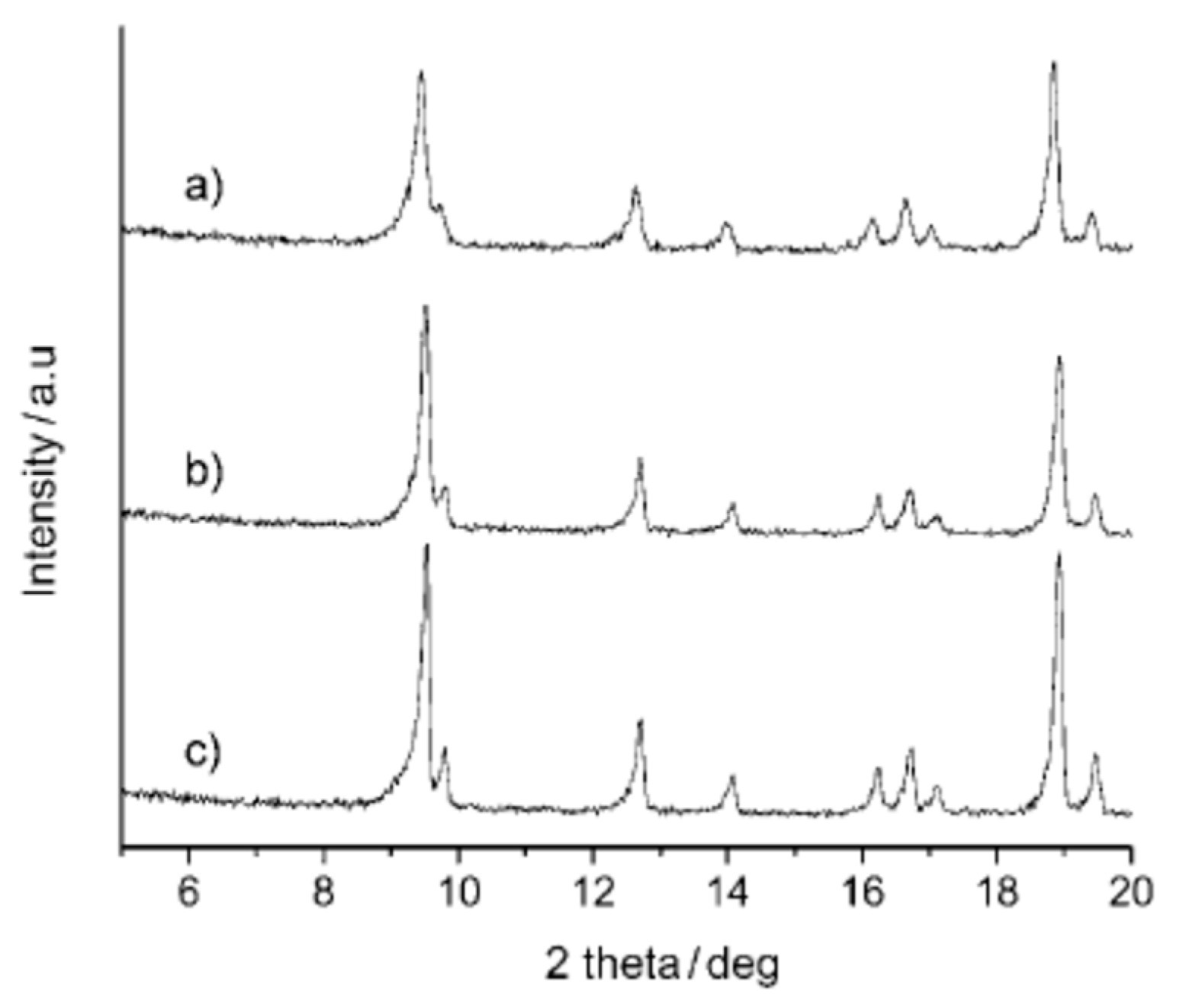
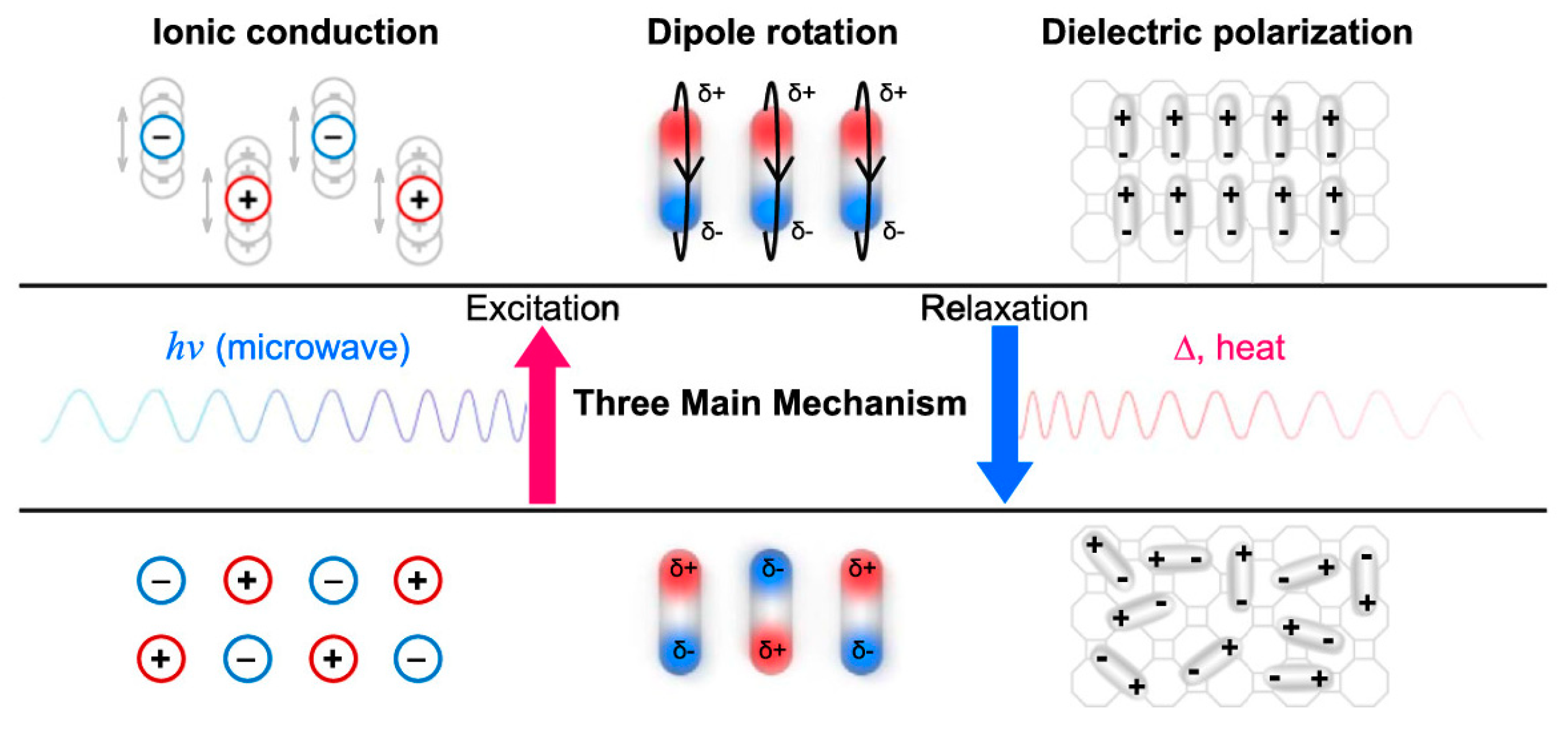
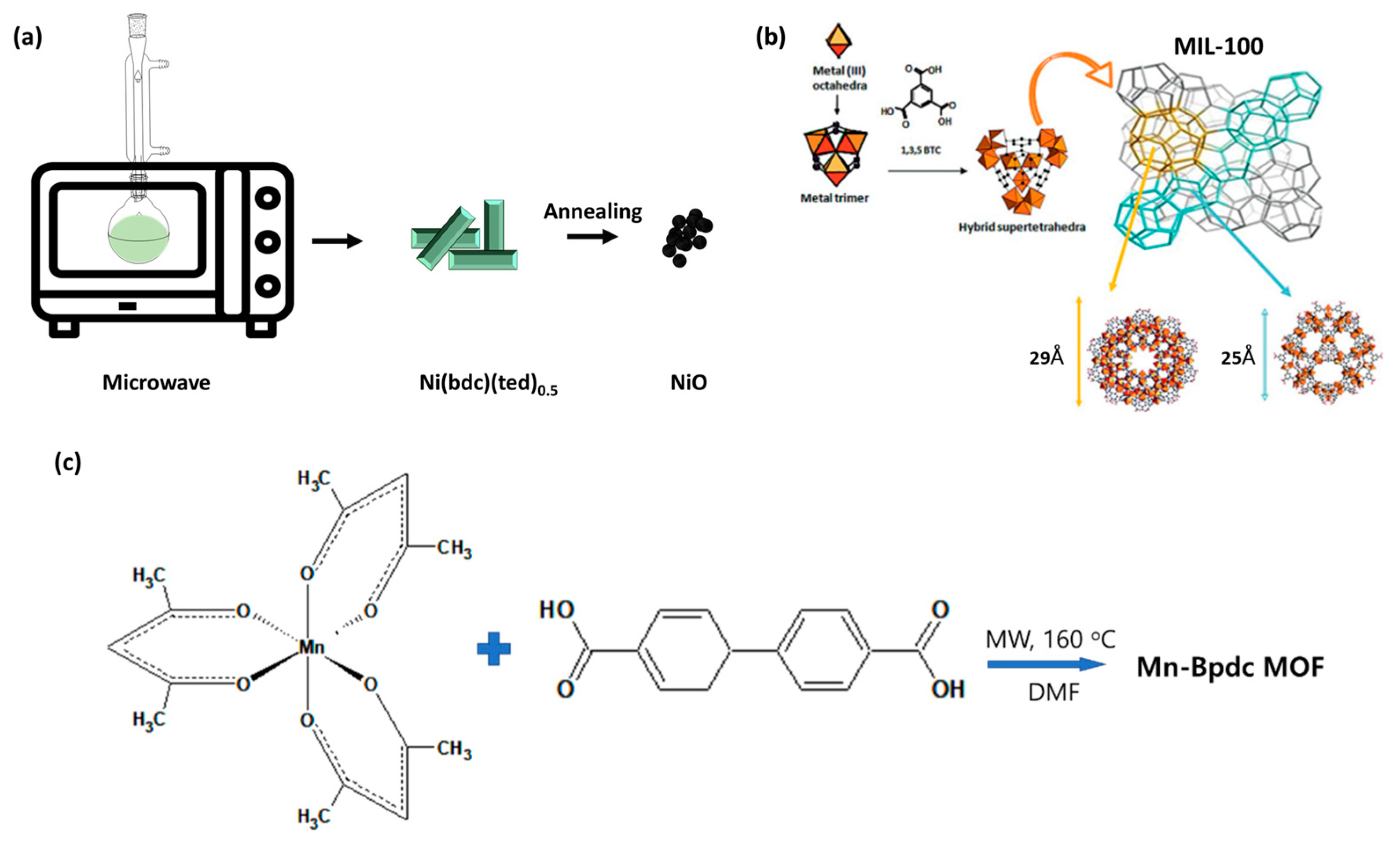
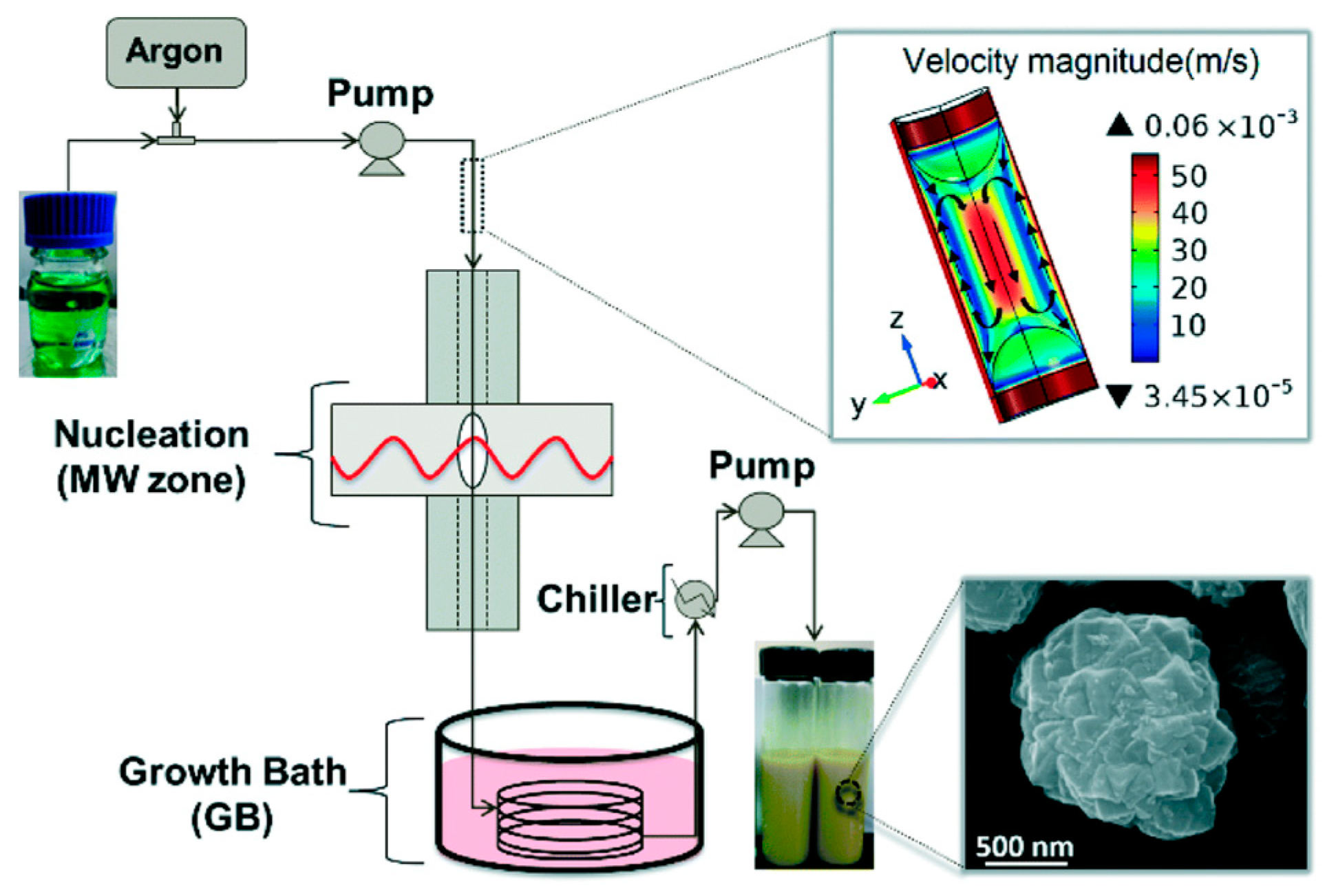





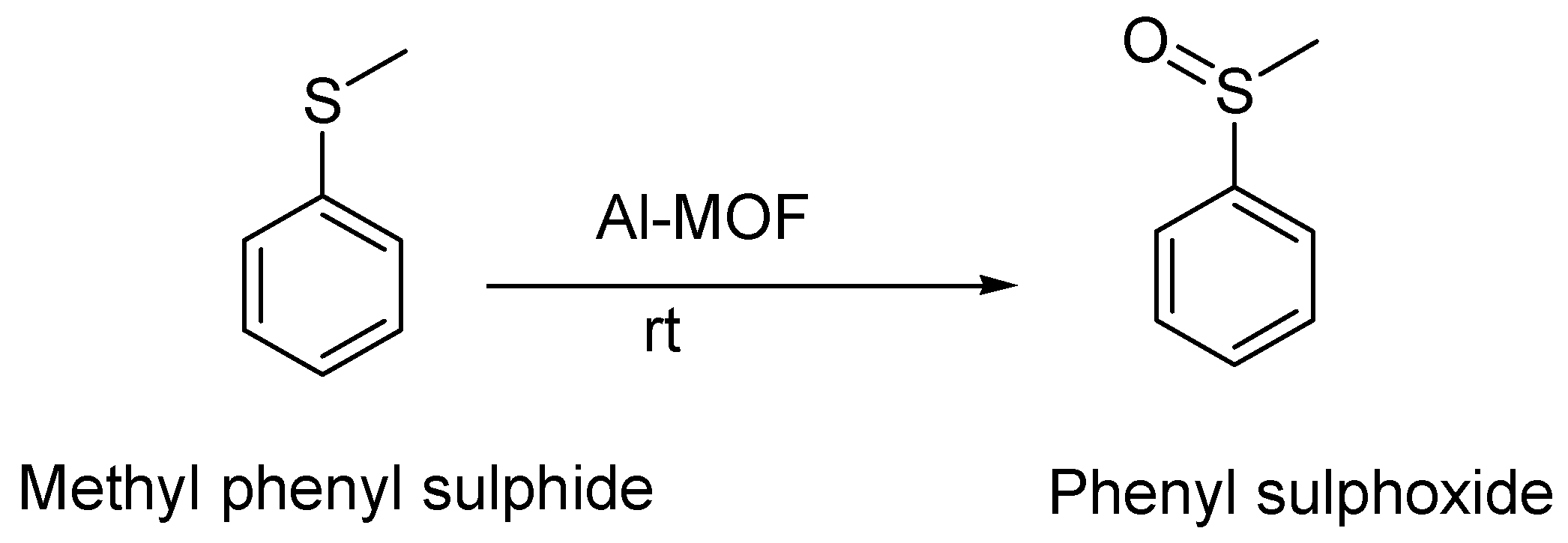

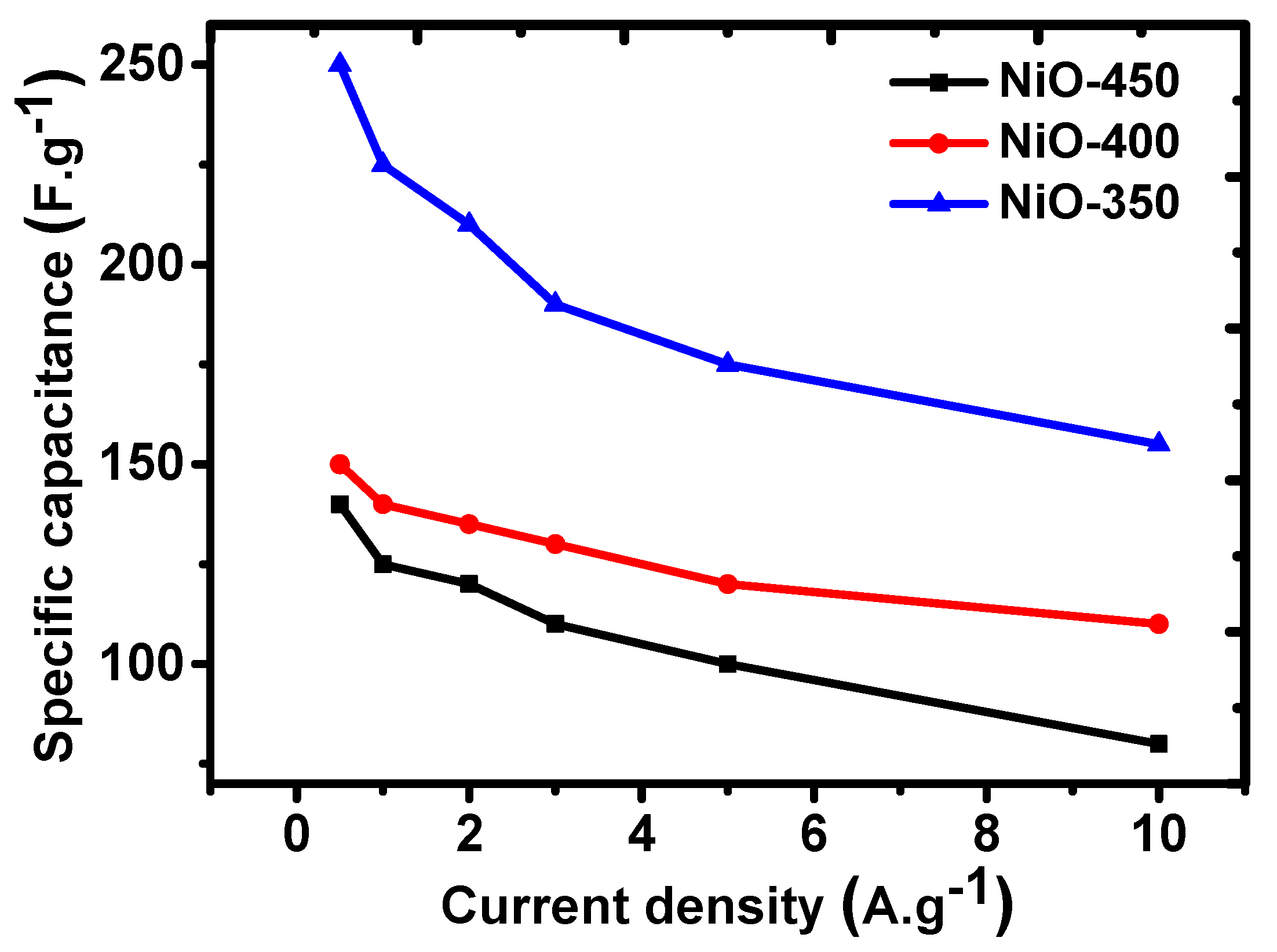
| MIL-53(Al) | Absorbed Power (W) | Relative Crystallinity (1/FWHM) |
| 269 | 5.20 | |
| 682 | 4.31 | |
| 945 | 4.76 | |
| 1739 | 5.17 | |
| 3819 | 4.46 |
| MnO/C Nanocomposite | Initial Discharge Capacity (mAh g−1) | Capacity Retention (%) | Capacity Fading (% per Cycle) |
| 851.6 | 81 | 0.189 |
Disclaimer/Publisher’s Note: The statements, opinions and data contained in all publications are solely those of the individual author(s) and contributor(s) and not of MDPI and/or the editor(s). MDPI and/or the editor(s) disclaim responsibility for any injury to people or property resulting from any ideas, methods, instructions or products referred to in the content. |
© 2023 by the authors. Licensee MDPI, Basel, Switzerland. This article is an open access article distributed under the terms and conditions of the Creative Commons Attribution (CC BY) license (https://creativecommons.org/licenses/by/4.0/).
Share and Cite
Phan, P.T.; Hong, J.; Tran, N.; Le, T.H. The Properties of Microwave-Assisted Synthesis of Metal–Organic Frameworks and Their Applications. Nanomaterials 2023, 13, 352. https://doi.org/10.3390/nano13020352
Phan PT, Hong J, Tran N, Le TH. The Properties of Microwave-Assisted Synthesis of Metal–Organic Frameworks and Their Applications. Nanomaterials. 2023; 13(2):352. https://doi.org/10.3390/nano13020352
Chicago/Turabian StylePhan, Pham Thi, Jeongsoo Hong, Ngo Tran, and Thi Hoa Le. 2023. "The Properties of Microwave-Assisted Synthesis of Metal–Organic Frameworks and Their Applications" Nanomaterials 13, no. 2: 352. https://doi.org/10.3390/nano13020352
APA StylePhan, P. T., Hong, J., Tran, N., & Le, T. H. (2023). The Properties of Microwave-Assisted Synthesis of Metal–Organic Frameworks and Their Applications. Nanomaterials, 13(2), 352. https://doi.org/10.3390/nano13020352








